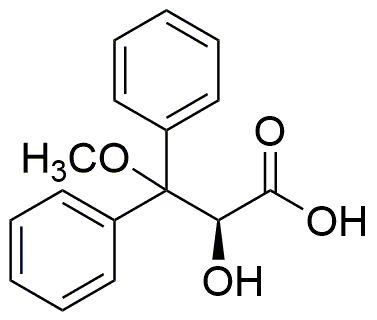(S)-2-Hydroxy-3-methoxy-3,3-diphenylpropionic acid is widely utilized in research focused on:
- Pharmaceutical Development: This compound serves as a key intermediate in the synthesis of various pharmaceuticals, particularly those targeting pain relief and anti-inflammatory effects. Its unique structure allows for enhanced bioactivity compared to similar compounds.
- Biochemical Research: Researchers use it to study enzyme interactions and metabolic pathways, providing insights into drug metabolism and efficacy. Its specificity can lead to more targeted therapeutic strategies.
- Cosmetic Formulations: The compound is incorporated into skincare products for its antioxidant properties, helping to protect skin cells from oxidative stress and promoting healthier skin.
- Agricultural Chemistry: It is explored as a potential agent in agrochemicals, contributing to the development of environmentally friendly pesticides that minimize harm to beneficial organisms.
- Material Science: The compound's unique properties are being investigated for use in creating advanced materials, such as polymers with enhanced thermal stability and mechanical strength.
General Information
Properties
Safety and Regulations
Applications
(S)-2-Hydroxy-3-methoxy-3,3-diphenylpropionic acid is widely utilized in research focused on:
- Pharmaceutical Development: This compound serves as a key intermediate in the synthesis of various pharmaceuticals, particularly those targeting pain relief and anti-inflammatory effects. Its unique structure allows for enhanced bioactivity compared to similar compounds.
- Biochemical Research: Researchers use it to study enzyme interactions and metabolic pathways, providing insights into drug metabolism and efficacy. Its specificity can lead to more targeted therapeutic strategies.
- Cosmetic Formulations: The compound is incorporated into skincare products for its antioxidant properties, helping to protect skin cells from oxidative stress and promoting healthier skin.
- Agricultural Chemistry: It is explored as a potential agent in agrochemicals, contributing to the development of environmentally friendly pesticides that minimize harm to beneficial organisms.
- Material Science: The compound's unique properties are being investigated for use in creating advanced materials, such as polymers with enhanced thermal stability and mechanical strength.
Documents
Safety Data Sheets (SDS)
The SDS provides comprehensive safety information on handling, storage, and disposal of the product.
Product Specification (PS)
The PS provides a comprehensive breakdown of the product’s properties, including chemical composition, physical state, purity, and storage requirements. It also details acceptable quality ranges and the product's intended applications.
Certificates of Analysis (COA)
Search for Certificates of Analysis (COA) by entering the products Lot Number. Lot and Batch Numbers can be found on a product’s label following the words ‘Lot’ or ‘Batch’.
Numéro de catalogue
Numéro de lot/série
Certificates Of Origin (COO)
This COO confirms the country where the product was manufactured, and also details the materials and components used in it and whether it is derived from natural, synthetic, or other specific sources. This certificate may be required for customs, trade, and regulatory compliance.
Numéro de catalogue
Numéro de lot/série
Safety Data Sheets (SDS)
The SDS provides comprehensive safety information on handling, storage, and disposal of the product.
DownloadProduct Specification (PS)
The PS provides a comprehensive breakdown of the product’s properties, including chemical composition, physical state, purity, and storage requirements. It also details acceptable quality ranges and the product's intended applications.
DownloadCertificates of Analysis (COA)
Search for Certificates of Analysis (COA) by entering the products Lot Number. Lot and Batch Numbers can be found on a product’s label following the words ‘Lot’ or ‘Batch’.
Numéro de catalogue
Numéro de lot/série
Certificates Of Origin (COO)
This COO confirms the country where the product was manufactured, and also details the materials and components used in it and whether it is derived from natural, synthetic, or other specific sources. This certificate may be required for customs, trade, and regulatory compliance.


